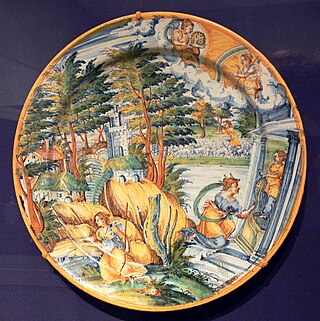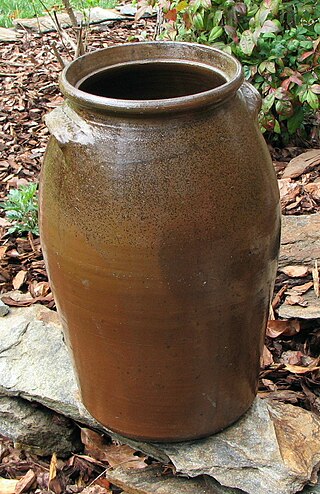
Seagrove is a town in Randolph County, North Carolina, United States. The population was 285 at the 2019 census. It was named after a railroad official when the area was connected by rail. In 2020, the center of population of North Carolina was located east of Seagrove.

Pottery and porcelain is one of the oldest Japanese crafts and art forms, dating back to the Neolithic period. Types have included earthenware, pottery, stoneware, porcelain, and blue-and-white ware. Japan has an exceptionally long and successful history of ceramic production. Earthenwares were made as early as the Jōmon period, giving Japan one of the oldest ceramic traditions in the world. Japan is further distinguished by the unusual esteem that ceramics hold within its artistic tradition, owing to the enduring popularity of the tea ceremony. During the Azuchi-Momoyama period (1573–1603), kilns throughout Japan produced ceramics with unconventional designs. In the early Edo period, the production of porcelain commenced in the Hizen-Arita region of Kyushu, employing techniques imported from Korea. These porcelain works became known as Imari wares, named after the port of Imari from which they were exported to various markets, including Europe.
The Penland School of Craft is an Arts and Crafts educational center located in the Blue Ridge Mountains in Penland, North Carolina in the Snow Creek Township near Spruce Pine, about 50 miles from Asheville.

Studio pottery is pottery made by professional and amateur artists or artisans working alone or in small groups, making unique items or short runs. Typically, all stages of manufacture are carried out by the artists themselves. Studio pottery includes functional wares such as tableware and cookware, and non-functional wares such as sculpture, with vases and bowls covering the middle ground, often being used only for display. Studio potters can be referred to as ceramic artists, ceramists, ceramicists or as an artist who uses clay as a medium.

North Carolina Highway 705 (NC 705) is a primary state highway in the U.S. state of North Carolina. The route is marked as the Pottery Highway or Pottery Road and as a North Carolina Scenic Byway due to the large number of potters in and surrounding Seagrove.

Alan Caiger-Smith MBE was a British ceramicist, studio potter and writer on pottery.

Goose Lake Prairie State Natural Area is a 2,537-acre (1,027 ha) state park in Illinois. More than half of the state park is a tallgrass prairie maintained as an Illinois Nature Preserve. It is located in Grundy County near the town of Morris approximately 50 miles (80 km) southwest of Chicago.

Tin-glazed pottery is earthenware covered in lead glaze with added tin oxide which is white, shiny and opaque ; usually this provides a background for brightly painted decoration. It has been important in Islamic and European pottery, but very little used in East Asia. The pottery body is usually made of red or buff-colored earthenware and the white glaze imitated Chinese porcelain. The decoration on tin-glazed pottery is usually applied to the unfired glaze surface by brush with metallic oxides, commonly cobalt oxide, copper oxide, iron oxide, manganese dioxide and antimony oxide. The makers of Italian tin-glazed pottery from the late Renaissance blended oxides to produce detailed and realistic polychrome paintings.

Catawba Valley Pottery describes alkaline glazed stoneware made in the Catawba River Valley of Western North Carolina from the early 19th century, as well as certain contemporary pottery made in the region utilizing traditional methods and forms.

Nancy Sweezy was an American artist, author, folklorist, advocate, scholar, and preservationist. Known initially for her work as a potter in the 1950s, Sweezy became a scholar of the history and creation of pottery and wrote several authoritative texts and books on U.S. and international folk pottery. She was a major figure in the establishment of markets for folk and traditional crafts. Other major accomplishments in her extensive career included the founding of the crafts organization Country Roads, the revival of North Carolina's historic Jugtown Pottery, and the creation of the Refugee Arts Group in Massachusetts for immigrant folk artists. Her advocacy work also included developing apprenticeship programs. She also was involved with Club 47, a famous performing scene in the American folk music revival.
Mark Hewitt is an English-born studio potter living in the small town of Pittsboro, North Carolina outside of Chapel Hill, North Carolina. In 2015 he received a United States Artist Fellowship, for contributions to the creative landscape and arts ecosystems of the country. He was a finalist for the 2015 Balvenie Rare Craft Fellowship Award, for contributions to the maintenance and revival of traditional or rare craft techniques. In 2014 he was awarded a Voulkos Fellowship at the Archie Bray Foundation for the Ceramic Arts in Helena, Montana, for outstanding contributions to the ceramic arts.

Owens Pottery of North Carolina, also known as Original Owens Pottery is the oldest, continuously-operating pottery in North Carolina. It sells a variety of traditional, functional clay products and is best known for its difficult-to-produce fire red glazed pottery. Owens Pottery is currently owned and operated by Boyd Owens.

Art pottery is a term for pottery with artistic aspirations, made in relatively small quantities, mostly between about 1870 and 1930. Typically, sets of the usual tableware items are excluded from the term; instead the objects produced are mostly decorative vessels such as vases, jugs, bowls and the like which are sold singly. The term originated in the later 19th century, and is usually used only for pottery produced from that period onwards. It tends to be used for ceramics produced in factory conditions, but in relatively small quantities, using skilled workers, with at the least close supervision by a designer or some sort of artistic director. Studio pottery is a step up, supposed to be produced in even smaller quantities, with the hands-on participation of an artist-potter, who often performs all or most of the production stages. But the use of both terms can be elastic. Ceramic art is often a much wider term, covering all pottery that comes within the scope of art history, but "ceramic artist" is often used for hands-on artist potters in studio pottery.

The Jugtown Historic District consists of a cluster of historic buildings surrounding the intersection of Harrison Street and Nassau Street in Princeton, New Jersey. The settlement dates to colonial times and is sometimes known as Queenston. In 1987, the district was listed on the National Register of Historic Places.

Ceramic art is art made from ceramic materials, including clay. It may take varied forms, including artistic pottery, including tableware, tiles, figurines and other sculpture. As one of the plastic arts, ceramic art is a visual art. While some ceramics are considered fine art, such as pottery or sculpture, most are considered to be decorative, industrial or applied art objects. Ceramic art can be created by one person or by a group, in a pottery or a ceramic factory with a group designing and manufacturing the artware.
The Mount Shepherd Pottery Site is a historic archaeological site on the grounds of the Mount Shepherd Retreat Center, outside Asheboro, North Carolina. The site is that of a late 18th-century pottery, possibly of Moravian origin. The principal feature of the site is a five-flued circular kiln, and it was accompanied by numerous pottery fragments and items, including stove tiles, slipware, earthenware, and smoking pipes. The site has been associated with Moravian master potter Gottfried Aust.

American art pottery refers to aesthetically distinctive hand-made ceramics in earthenware and stoneware from the period 1870-1950s. Ranging from tall vases to tiles, the work features original designs, simplified shapes, and experimental glazes and painting techniques. Stylistically, most of this work is affiliated with the modernizing Arts and Crafts (1880-1910), Art Nouveau (1890–1910), or Art Deco (1920s) movements, and also European art pottery.
Karl Martz was an American studio potter, ceramic artist, and teacher whose work achieved national and international recognition.

The Coxwold Pottery was a pottery studio based in the village of Coxwold, North Yorkshire, England, launched by artist potters Peter and Jill Dick in 1965, and in operation until 2012.
Katie Gold is a New Zealand potter.

















